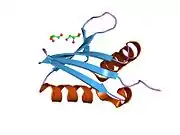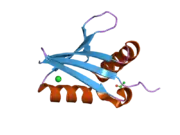| NBR1 | |||||||||||||||||||||||||||||||||||||||||||||||||||
|---|---|---|---|---|---|---|---|---|---|---|---|---|---|---|---|---|---|---|---|---|---|---|---|---|---|---|---|---|---|---|---|---|---|---|---|---|---|---|---|---|---|---|---|---|---|---|---|---|---|---|---|
 | |||||||||||||||||||||||||||||||||||||||||||||||||||
| |||||||||||||||||||||||||||||||||||||||||||||||||||
| Identifiers | |||||||||||||||||||||||||||||||||||||||||||||||||||
| Aliases | NBR1, 1A1-3B, IAI3B, M17S2, MIG19, neighbor of BRCA1 gene 1, autophagy cargo receptor, NBR1 autophagy cargo receptor | ||||||||||||||||||||||||||||||||||||||||||||||||||
| External IDs | OMIM: 166945 MGI: 108498 HomoloGene: 7438 GeneCards: NBR1 | ||||||||||||||||||||||||||||||||||||||||||||||||||
| |||||||||||||||||||||||||||||||||||||||||||||||||||
| |||||||||||||||||||||||||||||||||||||||||||||||||||
| |||||||||||||||||||||||||||||||||||||||||||||||||||
| |||||||||||||||||||||||||||||||||||||||||||||||||||
| |||||||||||||||||||||||||||||||||||||||||||||||||||
| Wikidata | |||||||||||||||||||||||||||||||||||||||||||||||||||
| |||||||||||||||||||||||||||||||||||||||||||||||||||
Neighbor of BRCA1 gene 1 protein is a protein that in humans is encoded by the NBR1 gene.[5][6]
The protein encoded by this gene was originally identified as an ovarian tumor antigen monitored in ovarian cancer. The encoded protein contains a B-box/coiled coil motif, which is present in many genes with transformation potential. This gene is located on a region of chromosome 17q21.1 that is in close proximity to tumor suppressor gene BRCA1. Three alternatively spliced variants encoding the same protein have been identified for this gene.[6] One implied function lies in autophagy, where it acts a cargo receptor in selective autophagy.[7]
Interactions
References
- 1 2 3 GRCh38: Ensembl release 89: ENSG00000188554 - Ensembl, May 2017
- 1 2 3 GRCm38: Ensembl release 89: ENSMUSG00000017119 - Ensembl, May 2017
- ↑ "Human PubMed Reference:". National Center for Biotechnology Information, U.S. National Library of Medicine.
- ↑ "Mouse PubMed Reference:". National Center for Biotechnology Information, U.S. National Library of Medicine.
- ↑ Campbell IG, Nicolai HM, Foulkes WD, Senger G, Stamp GW, Allan G, Boyer C, Jones K, Bast RC Jr, Solomon E (Sep 1994). "A novel gene encoding a B-box protein within the BRCA1 region at 17q21.1". Hum Mol Genet. 3 (4): 589–594. doi:10.1093/hmg/3.4.589. PMID 8069304.
- 1 2 "Entrez Gene: NBR1 neighbor of BRCA1 gene 1".
- ↑ Kirkin, Vladimir (2009). "A Role for Ubiquitin in Selective Autophagy". Molecular Cell. 34 (3): 259–269. doi:10.1016/j.molcel.2009.04.026. PMID 19450525.
- ↑ Whitehouse, Caroline; Chambers Julie; Howe Kathy; Cobourne Martyn; Sharpe Paul; Solomon Ellen (Jan 2002). "NBR1 interacts with fasciculation and elongation protein zeta-1 (FEZ1) and calcium and integrin binding protein (CIB) and shows developmentally restricted expression in the neural tube". Eur. J. Biochem. 269 (2): 538–545. doi:10.1046/j.0014-2956.2001.02681.x. ISSN 0014-2956. PMID 11856312.
Further reading
- Miki Y, Swensen J, Shattuck-Eidens D, et al. (1994). "A strong candidate for the breast and ovarian cancer susceptibility gene BRCA1". Science. 266 (5182): 66–71. Bibcode:1994Sci...266...66M. doi:10.1126/science.7545954. PMID 7545954.
- Harshman K, Bell R, Rosenthal J, et al. (1995). "Comparison of the positional cloning methods used to isolate the BRCA1 gene". Hum. Mol. Genet. 4 (8): 1259–1266. doi:10.1093/hmg/4.8.1259. PMID 7581362.
- Nomura N, Nagase T, Miyajima N, et al. (1995). "Prediction of the coding sequences of unidentified human genes. II. The coding sequences of 40 new genes (KIAA0041-KIAA0080) deduced by analysis of cDNA clones from human cell line KG-1". DNA Res. 1 (5): 223–229. doi:10.1093/dnares/1.5.223. PMID 7584044.
- Brown MA, Nicolai H, Xu CF, et al. (1995). "Regulation of BRCA1". Nature. 372 (6508): 733. Bibcode:1994Natur.372..733B. doi:10.1038/372733a0. PMID 7997258. S2CID 40825012.
- Brown MA, Xu CF, Nicolai H, et al. (1996). "The 5' end of the BRCA1 gene lies within a duplicated region of human chromosome 17q21". Oncogene. 12 (12): 2507–13. PMID 8700509.
- Dimitrov S, Brennerova M, Forejt J (2001). "Expression profiles and intergenic structure of head-to-head oriented Brca1 and Nbr1 genes". Gene. 262 (1–2): 89–98. doi:10.1016/S0378-1119(00)00549-7. PMID 11179671.
- Whitehouse C, Chambers J, Howe K, et al. (2002). "NBR1 interacts with fasciculation and elongation protein zeta-1 (FEZ1) and calcium and integrin binding protein (CIB) and shows developmentally restricted expression in the neural tube". Eur. J. Biochem. 269 (2): 538–545. doi:10.1046/j.0014-2956.2001.02681.x. PMID 11856312.
- Wistow G, Bernstein SL, Ray S, et al. (2002). "Expressed sequence tag analysis of adult human iris for the NEIBank Project: steroid-response factors and similarities with retinal pigment epithelium". Mol. Vis. 8: 185–95. PMID 12107412.
- Strausberg RL, Feingold EA, Grouse LH, et al. (2003). "Generation and initial analysis of more than 15,000 full-length human and mouse cDNA sequences". Proc. Natl. Acad. Sci. U.S.A. 99 (26): 16899–16903. Bibcode:2002PNAS...9916899M. doi:10.1073/pnas.242603899. PMC 139241. PMID 12477932.
- Lamark T, Perander M, Outzen H, et al. (2003). "Interaction codes within the family of mammalian Phox and Bem1p domain-containing proteins". J. Biol. Chem. 278 (36): 34568–34581. doi:10.1074/jbc.M303221200. PMID 12813044.
- Ota T, Suzuki Y, Nishikawa T, et al. (2004). "Complete sequencing and characterization of 21,243 full-length human cDNAs". Nat. Genet. 36 (1): 40–45. doi:10.1038/ng1285. PMID 14702039.
- Gerhard DS, Wagner L, Feingold EA, et al. (2004). "The status, quality, and expansion of the NIH full-length cDNA project: the Mammalian Gene Collection (MGC)". Genome Res. 14 (10B): 2121–2127. doi:10.1101/gr.2596504. PMC 528928. PMID 15489334.
- Lange S, Xiang F, Yakovenko A, et al. (2005). "The kinase domain of titin controls muscle gene expression and protein turnover". Science. 308 (5728): 1599–1603. Bibcode:2005Sci...308.1599L. CiteSeerX 10.1.1.383.9888. doi:10.1126/science.1110463. PMID 15802564. S2CID 2809403.
- Rual JF, Venkatesan K, Hao T, et al. (2005). "Towards a proteome-scale map of the human protein-protein interaction network". Nature. 437 (7062): 1173–1178. Bibcode:2005Natur.437.1173R. doi:10.1038/nature04209. PMID 16189514. S2CID 4427026.
This article is issued from Wikipedia. The text is licensed under Creative Commons - Attribution - Sharealike. Additional terms may apply for the media files.







